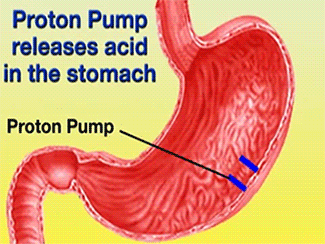User:Alisha, Deepa, Pamiz/Sandbox 1
From Proteopedia
(→H+/K+-ATPase) |
(→H+/K+-ATPase) |
||
| Line 8: | Line 8: | ||
The H+/K+-ATPase pump is part of the P-type ATPase family located within the cytoplasmic membrane of resting parietal cells (Figure 1); powered through ATP hydrolysis, the ATPase is translocated to the canalicular membrane and begins to pump cytoplasmic H+ into the canalicular space, in exchange for extracellular K+ ions. It is a pro-drug that is protonated twice in the acidic environment of the parietal cell to form the active inhibitor, sulfenamide which forms disulfide bonds with Cys 813 and Cys 892 on the α subunit of the H+/K+-ATPase.3[[Image:cell.jpg|300px|right|thumb|] '''Cartoon representation of Parietal Cell''' Image courtesy of ...]] Targeting this enzyme using PPIs is the most effective therapeutic control agent of gastric acid secretion.3 | The H+/K+-ATPase pump is part of the P-type ATPase family located within the cytoplasmic membrane of resting parietal cells (Figure 1); powered through ATP hydrolysis, the ATPase is translocated to the canalicular membrane and begins to pump cytoplasmic H+ into the canalicular space, in exchange for extracellular K+ ions. It is a pro-drug that is protonated twice in the acidic environment of the parietal cell to form the active inhibitor, sulfenamide which forms disulfide bonds with Cys 813 and Cys 892 on the α subunit of the H+/K+-ATPase.3[[Image:cell.jpg|300px|right|thumb|] '''Cartoon representation of Parietal Cell''' Image courtesy of ...]] Targeting this enzyme using PPIs is the most effective therapeutic control agent of gastric acid secretion.3 | ||
| - | [[Image:alphabetasubunits.jpg|300px|left|thumb|]''' Esomeprazole is an α,β-heterodimeric enzyme''' Ribbon representation model of H+/K+-ATPase.6 This transmembrane protein consists of α (cytosol facing) and β (lumen facing) subunits and three domains: A (blue), N (green), and P (orange). The 10 TM helices of the α subunit (TM1-10) are depicted in rainbow colors.]]The structure of H+/K+-ATPase is an α,β-heterodimeric enzyme, where the catalytic site is present in the α subunit (Figure 2).7 Transmembrane segments TM4, TM5, TM6, and TM8, are located in the α subunit and contain the ion binding region of the enzyme.7 Binding of ions and ATP to these domains will induce movements in the membrane domain that catalyze ion displacement.7 | + | [[Image:alphabetasubunits.jpg|300px|left|thumb|]''' Esomeprazole is an α,β-heterodimeric enzyme''' Ribbon representation model of H+/K+-ATPase.6 This transmembrane protein consists of α (cytosol facing) and β (lumen facing) subunits and three domains: A (blue), N (green), and P (orange).]] The 10 TM helices of the α subunit (TM1-10) are depicted in rainbow colors.]]The structure of H+/K+-ATPase is an α,β-heterodimeric enzyme, where the catalytic site is present in the α subunit (Figure 2).7 Transmembrane segments TM4, TM5, TM6, and TM8, are located in the α subunit and contain the ion binding region of the enzyme.7 Binding of ions and ATP to these domains will induce movements in the membrane domain that catalyze ion displacement.7 |
== CONFORMATIONAL CHANGE OF H+/K+-ATPase | == CONFORMATIONAL CHANGE OF H+/K+-ATPase | ||
Revision as of 03:38, 6 December 2013
Introduction
H+/K+-ATPase
The H+/K+-ATPase pump is part of the P-type ATPase family located within the cytoplasmic membrane of resting parietal cells (Figure 1); powered through ATP hydrolysis, the ATPase is translocated to the canalicular membrane and begins to pump cytoplasmic H+ into the canalicular space, in exchange for extracellular K+ ions. It is a pro-drug that is protonated twice in the acidic environment of the parietal cell to form the active inhibitor, sulfenamide which forms disulfide bonds with Cys 813 and Cys 892 on the α subunit of the H+/K+-ATPase.3 Targeting this enzyme using PPIs is the most effective therapeutic control agent of gastric acid secretion.3== CONFORMATIONAL CHANGE OF H+/K+-ATPase
Inorganic Pi produced from the hydrolysis of ATP drives a conformational change in the enzyme and allows release of H+ into the highly acidic environment.5 The enzyme catalyzes this reaction by changing conformation states between E1 and E2 (Scheme 1).6
The interaction between Esomeprazole and H+/K+-ATPase has not yet been crystallized.15 However, data obtained from the crystallized structure of a SCH28080-ATPase provides structural and binding site information.16 SCH28080 is a competitive K+ inhibitor that interacts with the enzyme’s Phe126 residue and prevents disulfide bond formation between Omeprazole and Cys813.16 This suggests that SCH28080 and Esomeprazole have mutually exclusive inhibitions showing an overlapping binding site.16 The crystallized structure of SCH28080-ATPase shows the same luminal-open (E2) conformation as Esomeprazole, and is the first and only crystallized evidence of PPI-ATPase binding site and conformational change.16 Using this information, the SCH28080-ATPase crystallized structure provides evidence of the two binding sites, Cys813 and Cys892.15,16 The binding pocket, as proposed using SCH28080 includes the following residues: Glu936, Lys791, Glu795, Cys813, Cys892, Phe126, and Glu822 (Figure 5). The negatively charged residues within the TM domains are important for K+ binding and are conserved in all P-type ATPases.16 The SCH28080 model shows that electrostatic and hydrophobic factors affect drug-enzyme interaction.16
![] Cartoon representation of Parietal Cell Image courtesy of ...](/wiki/images/thumb/e/e8/Cell.jpg/300px-Cell.jpg)

